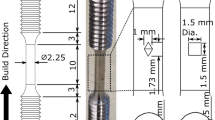Abstract
A failure analysis investigation was performed on the remnants of a carbon fiber rudder stock that fractured during operation on a vessel in an offshore sailing race. 3D X-ray microcomputed tomography, light microscopy and scanning electron microscopy techniques were utilized to characterize manufacturing quality, mode(s) of failure, fracture surfaces and design geometry. The CT scan slices showed signs of large-scale air entrapment, porosity and voids in the order of 10% by volume. CT gray-scale variations indicated material density differences, which allowed for differentiation between air entrapments, resin rich locations, fiber plies and shifting of material during manufacturing. The analysis also revealed the use of a solid, cylindrical balsa wood core, with unidirectional carbon fiber plies oriented around the core and off-axis bias plies along the outer circumference of the rudder stock. Fracture of the rudder occurred near the transition from the blade to post at the bearing interface. Fractographic analysis revealed signs of fractured carbon fibers—brooming and longitudinal splitting with areas of both adequate residual fiber matrix adhesion, and areas of dry fibers indicating poor wet-out. Manufacturing flaws found within the rudder post and along the fracture surface suggest it was a likely contributing factor leading to premature failure during service. Review of the intended design drawings shows that a hollow rhomboid stock design was specified; however, a solid cylindrical carbon fiber design was built, with a rapid transition and area reduction near the bearing interface. The manufacturing process used was a hand layup technique with vacuum consolidation. This process utilized with the size and geometry of a solid core design limited overall compaction of the resin and fibers, which exacerbated air entrapment and void formation. Fracture occurred at the bearing interface, due to the constraint and transition from a round solid core to a reduced area rhomboid “neck” geometry of the blade under hydrodynamic forces.









Similar content being viewed by others
References
P. Schilling et al., X-ray computed microtomography of internal damage in fiber reinforced polymer matrix composites. Compos. Sci. Technol. 65(2005), 2071–2078 (2005)
K.T. Tan, N. Watanabe, Y. Iwahori, X-ray radiography and micro-computed tomography examination of damage characteristics in stitched composites subjected to impact loading. Compos. Part B 42(2011), 874–884 (2011)
J. Kastner, B. Plank, D. Salaberger, J. Sekelja, in Defect and Porosity Determination of Fibre Reinforced Polymers by X-Ray Computed Tomography. 2nd International Symposium on NDT in Aersopace (2010)
E. Bayraktar, S. Antolonovich, C. Bathias, Multiscale study of fatigue behavior of composite materials by x-rays computed tomography. Int. J. Fatigue 28, 1322–1333 (2006)
P. Wright, X. Fu, I. Sinclair, S.M. Spearing, Ultra high resolution computed tomography of damage in notched carbon fiber-epoxy composites. J. Compos. Mater. 42, 1993–2002 (2008)
S.C. Garcea, Y. Wang, P.J. Withers, X-ray computed tomography of polymer composites. Compos. Sci. Technol. 156, 305–319 (2018)
M. Rauer, A. Volkert, T. Schreck, S. Harter, M. Kaloudis, Computed tomography based analysis of void in SnBi57Ag1 solder joints and their influence on the reliability. J. Fail. Anal. Prev. 14, 272–281 (2014)
E. Rolfe, M. Kelly, H. Arora, P. Hooper, J. Dear, Failure analysis using x-ray computed tomography of composite sandwich panels subjected to full-scale blast loading. Compos. B 129, 26–40 (2017)
P. Stumpff, Practical Failure Analysis. ASM Handbook, Vol. 21, Composites (ASM International, Russell Township, 2001), pp. 988–993
Acknowledgments
I acknowledge and thank the technical staff at Kars’ Advanced Materials Inc. for their discussions and assistance.
Author information
Authors and Affiliations
Corresponding author
Additional information
Publisher's Note
Springer Nature remains neutral with regard to jurisdictional claims in published maps and institutional affiliations.
Rights and permissions
About this article
Cite this article
Kar, N.K., Bovie, A. Failure Analysis of a Composite Rudder Stock Using 3D X-ray Microcomputed Tomography. J Fail. Anal. and Preven. 19, 24–28 (2019). https://doi.org/10.1007/s11668-019-00601-5
Received:
Published:
Issue Date:
DOI: https://doi.org/10.1007/s11668-019-00601-5




